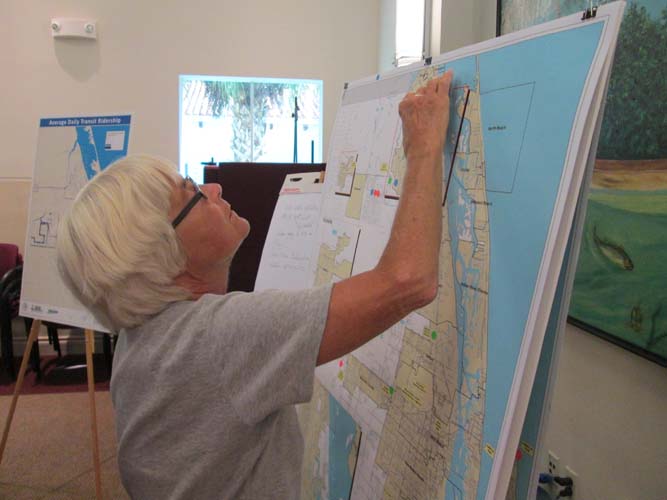INDIAN RIVER COUNTY — More hours, more routes and more shelters – that’s what GoLine riders in Sebastian, Fellsmere, and Vero Lake Estates told county officials they hope to get more out of the bus service.
Public input was sought at two meetings as part of a required planning process that takes place every five years.
Last go-round, northern residents saw changes to the bus system that included Saturday service and new routes. This time around, transportation officials believe improvements could be in the form of more shelters and more hubs – or bus connections.
“There are no immediate revelations,” said Phil Matson, staff director of the Indian River County Metropolitan Planning Organization, coming from the whirlwind series of workshops held early last week. A fifth workshop was held Wednesday to give residents another chance to weigh in.
Though the workshops were well-attended in Gifford and Vero Beach, turnout and participation in Fellsmere and Sebastian was sparse.
At both workshops, transportation staff and elected officials outnumbered the general public – attracting about a dozen at each.
The lack of attendance in Sebastian frustrated Councilwoman Andrea Coy, though she wasn’t surprised.
She pointed out that north county residents were given one week’s notice about the daytime workshops and fliers that were supposed to be circulated on the buses didn’t make the rounds.
Instead, frequent rider and Sebastian resident Judith Bewersdorf printed out fliers at her home and distributed them the day before the workshops.
Fellsmere Councilwoman Sara Savage attended the Fellsmere workshop in her husband, Evencio’s, stead.
He is a regular bus rider, according to Savage, and often takes the bus to get to Sebastian to see the doctor or run errands. Savage, too, rides the bus, though only a couple times each year.
Both Fellsmere and Sebastian’s city councils have put off contributing financially to the GoLine system because they feel there is an issue of fairness to be considered.
Fellsmere and Sebastian have contributed $50,000 each, per year for the last few years, while the City of Vero Beach has not. Instead, Vero’s leaders have offered up a piece of property for a possible bus hub.
Fellsmere City Manager Jason Nunemaker said the cities are working together to come up with some resolution to the funding fairness issue and expects that they will participate financially on some level.
And while Fellsmere’s Councilwoman Savage said she’s supportive of the system, Sebastian Councilwoman Coy remains opposed to cutting a $50,000 to GoLine. She said nothing she saw during the workshop changes her stance on funding the system.
“I’m very disappointed” in the workshops, Coy said, pointing to the lack of promotion and subsequent lack of attendance and participation. She said she’d reconsider her position if she were to see results from the process. Those results would have to include reconfiguring the system to accommodate riders – not the system itself.
Coy explained that the timing of the stops is in one-hour increments, which is fine for the bus drivers, but isn’t necessarily fine for the riders. She pointed to one rider she knows who lives on Schumann Drive a half-mile from US 1. It takes him 90 minutes to get to Walmart. “That’s not convenient,” she said.
Sebastian bus rider Bewersdorf attended the Sebastian workshop to provide her own feedback on the Go- Line system. Aside from riding the bus to get to Publix, Walmart and the Indian River Mall, she said she’d like to see better service out to the island from north county.
“I have to take four buses to get there,” Bewersdorf said. “It’s not worth it.” She explained that it takes two and a half hours just to get to the beach.
Bewersdorf said more routes through Sebastian would also be helpful. As it is, there are just two routes that go through the neighborhoods of Sebastian – Route 5 and 12. Route 13 runs through Sebastian along US 1 up to Barefoot Bay.
Vero Lake Estates resident Elida Gomez said a new route should also be added to go through her community.
Residents, now, have to walk out to either County Road 510 or County Road 512 to catch a bus.
Gomez suggested a route along 101st Avenue – the main street through the community – would benefit the residents.
“It’s a safety issue,” she said.
In Fellsmere, a couple residents participated in a mapping exercise, placing colored stickers on the map of the county to show where they live, where they typically travel to, and where they’d like to go.
Due to the large Hispanic population in Fellsmere, the workshop was held in both English and Spanish and most of the residents in attendance were Spanish speakers.
“Fellsmere really benefits from it,” said Councilman Joel Tyson of the GoLine service.
Not a bus rider himself, Tyson said he would use it if he didn’t have his car.
He added that he has heard from residents that they’d like to see the buses be equipped with bicycle racks.
Many of Fellsmere’s residents rely on bicycles to get around town and the bus to travel outside the city.
The workshops were just the latest step in what will ultimately be a nearly year-long process to find efficiencies, prioritize needs, and further enhance public transportation throughout Indian River County.
With the workshops complete, consulting firm Stanley Consultants Inc. will compile the data gleaned from the map sticker exercises and comment cards and surveys and analyze it.
From there, recommendations for changes will be formulated and another round of public input is expected to be solicited sometime in May.
Consultant Freddie Vargas said the proposed changes could be presented to the Board of County Commissioners in July and forward it to the Florida Department of Transportation in August.

